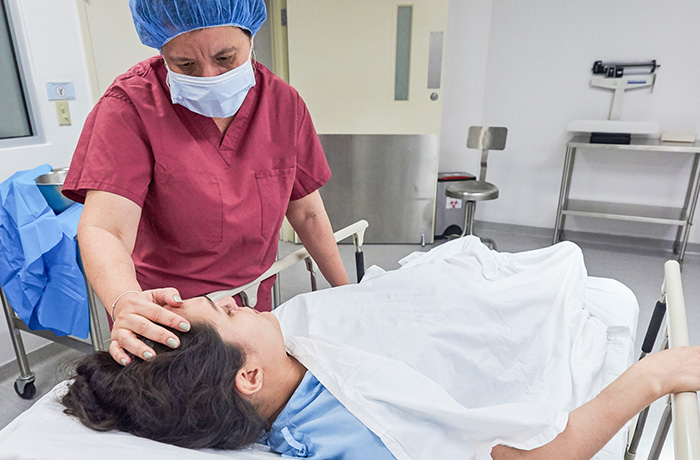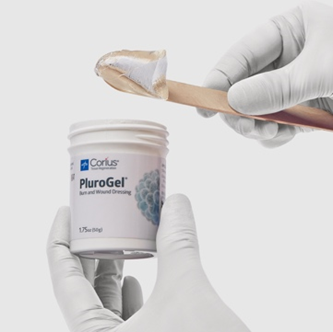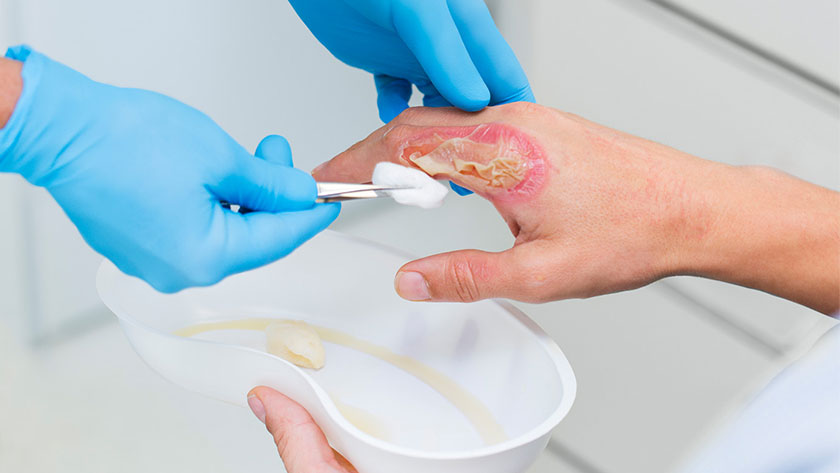Burn wound care has received growing attention recently, as record heatwaves have resulted in serious burns from hot asphalt. In July 2023, every bed at the Arizona Burn Center at Valleywise Health was full, and 30% of those patients were burned by falling on hot pavement.1
Hotter days with little to no cool-off at night means asphalt absorbs a significant amount of solar radiation. People who touch heat-conducting surfaces, like metal doorknobs, or fall onto hot asphalt can experience second- or third-degree contact burns. This can cause skin injuries, especially among the elderly population who may not be able to get up without assistance. It can take a fraction of a second to experience a burn and minutes for full-thickness burns.1
With air temperatures over 110 degrees Fahrenheit in some areas of the US, asphalt can heat up to as high as 180 degrees.1 Putting that in perspective: When skin is at just 118 degrees it can suffer from a first-degree burn.2
According to the American Burn Association, approximately 486,000 people in the United States receive burn wound care for treatment of burn injuries each year.3 Clinicians like you could see that number rise as climate change brings longer periods of sustained high temperatures.4
Second degree burn vs. third degree burn
Depending on the duration of contact with the hot surface and temperature of the surface, an individual may experience a first-, second- or third-degree burn.
First-degree burns can typically be cared for at home, while a second-degree burn may require medical care. Third-degree burns are more serious and may be what you encounter most often. Here are some distinguishing factors between second- and third-degree burns.
Second-degree burn characteristics5
Severity: Mild to moderate
Depth of injury: Epidermis and dermis
Features: Deep red to dark brown; possible blistering; shiny, moist appearance; pain or discomfort; possible swelling or skin peeling
Third-degree burn characteristics6
Severity: Serious, requiring immediate medical attention
Depth of injury: Epidermis, dermis and the hypodermis, the layer of fat underneath the skin; may also damage sweat glands, hair follicles and nerve endings
Features: Some similar qualities of a second-degree burn such as possible blistering, and shiny, moist skin; also leathery, dry skin; skin discoloration that’s white, black or bright red; swelling
Managing pain of burn wound care
Burn care can be challenging because patients often feel anxious about the pain associated with treatment, especially dressing changes.7
Studies show that when patients experience pain during a dressing change, it increases their stress level, which can lead to a greater sense of pain at the next dressing change. This vicious cycle can become a real barrier to healing.8
A better dressing
Clinicians are always looking for new and better solutions to help reduce patient-reported pain and stress, while still advancing the healing process. One of those solutions is the innovative burn and wound dressing, PluroGel, the only concentrated surfactant designed to hydrate the wound, manage biofilm9 and provide gentle debridement as an immediate intervention topical in burn care.
What makes PluroGel so unique is that it helps promote patient comfort and compliance by reducing patient-reported pain to make the dressing change less uncomfortable. Clinicians report that PluroGel goes on and rinses off gently, so patients report less pain and anxiety during dressing changes. It can also provide a soothing and cooling sensation.
Why dressing changes are key
According to studies, the most stressful part of burn wound treatment for patients is the dressing change.8 But it’s also crucial to wound healing.
PluroGel helps achieve several clinical goals:
- Speeds demarcation of the wound
- Disrupts and prevents biofilm formation 9
- Helps provide a moist wound environment, which aids in the removal of necrotic tissue
- Reduces patient discomfort during dressing changes

Naiwei Hsu-Chang RN, CCRN, Medline consultant and lead RN at the Burn Center of the Torrance Memorial Medical Center in California has been a burn care nurse for 35 years and has seen an evolution in burn care as well as a shift in the relationship between the burn care nurse and the physician. “Early on, it was totally driven by the physician,” she says. “And now it is very much a coordinated effort between nursing and physicians.”
As a clinician, your role in burn wound care is crucial, so it’s important that you know how to help reduce your patients’ reported pain. We asked Hsu-Chang to provide her experience with managing burn pain, while achieving optimal healing.
Q. What makes treating burns so challenging for wound care nurses?
A. One challenge of burn wound care is that when a patient reports a lot of pain, it takes longer to change their dressings. When the patients are focused on their pain experience, it’s difficult for them to learn all the important information on burn care.
It’s individualized and sometimes up to the nurse
to determine the pain level
Q. How does a patient’s reported pain level during dressing changes affect the clinician?
A. Nurses are affected by a patient’s pain level because we’re always trying to find a level of pain that’s tolerable for the patient. If the pain is unbearable, it slows down the treatment, and we wouldn’t force the person to go through a painful dressing change without intervening to help reduce the pain. A nurse would never watch a patient suffer. So, if you have to stop every 15 minutes to provide pain medicine, it naturally takes longer to change the dressing.
Q. When a patient reports pain during a dressing change, how can a wound care nurse respond?
A. Be sure to talk to your patient. You can say, ‘In order to get you well, this is what we have to do. If we forego the dressing change, then the consequence is your wound may get infected and you might be in worse shape than you are now.’ You can also explain, ‘You’re here, you have this injury, we have to get through this together, but in order to get to the next step and help heal the wound, we have to do this.’

Q.How might wound healing be impacted if the patient’s reported pain level is very high?
A. This is what we always tell people: Pain is very difficult to measure; it’s very subjective. When people are constantly in pain, they don’t eat well, and if they don’t get proper nutrition, that could slow their healing. It’s not something people can really see right away, but it has a relationship. When you have less pain, you can exercise better, you can eat better and you can heal faster. If you’re plagued by pain and curled into a ball, then you can’t think beyond the pain, and that slows your healing.
Q. PluroGel is a newer treatment for burns. How can it help reduce patient-reported pain levels?
A. PluroGel is a product that I use to help patients feel more comfortable during dressing changes. Because it helps people feel less discomfort, it cuts down on dressing change time and saves valuable nursing time. It also means we could potentially use less pain medication and, because pain can delay a patient being discharged, it may also mean reduced length of hospital stay. PluroGel is also water-soluble and can be removed easily with any normal wound cleanser.
Q. How else can PluroGel burn and wound dressing help nurses and patients?
A. PluroGel effectively removes necrotic tissue. It is also biocompatible with the body and is gentle on new tissue in the wound bed so it should not sting when it touches the wound.
Q. What else should nurses know about PluroGel burn and wound dressing?
A. PluroGel exhibits inverse thermodynamics and the gel liquefies. As a liquid, it might be runny, so if the wound is on the posterior aspect of the body, it can be difficult to apply the dressing as opposed to a burn on the anterior side of the body. There’s a technique to doing it correctly, so it’s a good idea for a new nurse to consult with someone who has used PluroGel before and can demonstrate the process.

Q. What else can nurses do to help reduce reported pain levels for burn patients?
A. We like to try different things like distraction to help patients manage their pain naturally and use medication as the last resort. Recently, I was removing a staple on a patient, and he was talking about his fishing trip, so I asked someone else to come into the room who is also a fisherman. The patient was so engaged in something unrelated to what I was doing, that we went through the whole procedure without medication.
“We try to make the experience more comfortable, but it’s very important that nurses set expectations.”
We also use visual meditations, virtual reality and music. Virtual reality is something we haven’t used a lot of, but it works well when we do, especially with young people who are good with technology. Of course, if the burn is on their face, it wouldn’t be possible, as they have to wear goggles.
Q. What’s the bottom line when it comes to patient-reported pain during burn wound treatment?
A.. We try to make the experience more comfortable, but it’s very important that nurses set expectations. If you tell someone they won’t have pain, that’s not possible. We say, it’s not possible to take the pain away, but we can make the pain more manageable. We try to make the experience as tolerable as possible, and when you explain that to the patient, the patient will appreciate that you care about their well-being. The patient will let you do more when they feel they’re not just a project, but that you really care. A caring manner goes a long way.
“The patient will let you do more when they feel they’re not just a project, but that you really care.”
Key takeaway
Treating burn patients is never easy. When dressing changes are uncomfortable for a patient, it can slow down the treatment process and could lead to longer hospital stays. And nurses certainly don’t want to cause their patient discomfort. By using the concentrated surfactant gel, PluroGel, you can help reduce reported pain and stress during burn wound dressing changes, while still effectively achieving removal of necrotic tissue. Combined with other strategies, such as music, meditation, virtual reality and distraction, you can show your patient you care about their comfort and help reduce patient-reported pain during burn wound dressing changes.
More about PluroGel
Get the inside story on the first and only concentrated surfactant for wound bed preparation. Discover patient stories, videos and more at MedlineCorius.com/PluroGel.
References:
- Christensen, J. (2023, July 24). It’s so hot in Arizona, doctors are treating a spike of patients who were burned by falling on the ground. CNN Health. https://www.cnn.com/2023/07/24/health/arizona-heat-burns-er/index.html
- Fire Dynamics | NIST. (2021). NIST. https://www.nist.gov/el/fire-research-division-73300/firegov-fire-service/fire-dynamics
- Burn incidence Fact Sheet – American Burn Association. (n.d.). https://ameriburn.org/who-we-are/media/burn-incidence-fact-sheet/
- Center for Climate and Energy Solutions. (2023, July 14). Heat Waves and Climate Change – Center for Climate and Energy Solutions. https://www.c2es.org/content/heat-waves-and-climate-change/
- Professional, C. C. M. (n.d.). Second-Degree burn. Cleveland Clinic. https://my.clevelandclinic.org/health/symptoms/24527-second-degree-burn
- Professional, C. C. M. (n.d.-b). Third-Degree burn. Cleveland Clinic. https://my.clevelandclinic.org/health/symptoms/24531-third-degree-burn
- Griggs, C. L., Goverman, J., Bittner, E. A., & Levi, B. (2017). Sedation and pain management in burn patients. Clinics in Plastic Surgery, 44(3), 535–540. https://doi.org/10.1016/j.cps.2017.02.026
- Griggs, C., Goverman, J., Bittner, E. A., & Levi, B. (2017). Sedation and Pain Management in Burn Patients. Clinics in plastic surgery, 44(3), 535–540. https://doi.org/10.1016/j.cps.2017.02.026
- Yang, Q., Larose, C., Della Porta, A. C., Schultz, G. S., & Gibson, D. J. (2016). A surfactant-based wound dressing can reduce bacterial biofilms in a porcine skin explant model. International Wound Journal, 14(2), 408–413. https://doi.org/10.1111/iwj.12619

